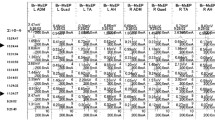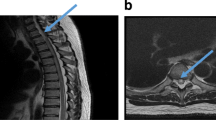Abstract
Transient sensory disturbances, including dysesthesia or neurologic deficits in the lower extremities or buttocks have been described as complications of neuraxial anesthesia. We report a case of transient lower limb pain following the accidental placement of an epidural catheter into the thoracic subarachnoid space. A 31-year-old woman was scheduled to undergo laparoscopic myomectomy. An epidural catheter was accidentally inserted subarachnoid at the T12–L1 intervertebral space with a 2-ml test dose of 2% lidocaine, and was promptly removed. Fulgurant pain and allodynia extending over the L2–5 areas of the left lower limb and buttock started immediately postoperatively. We treated the persistent pain in our patient with epidural infusion of local anesthetics and steroids during her hospital stay, and with carbamazepine and a tricyclic antidepressant after her discharge from the hospital. All signs of allodynia had disappeared on postoperative day 25. Sagittal and axial T2-weighted magnetic resonance imaging (MRI) at the Th12 level revealed a small high-intensity area without mass effect in the ipsilateral dorsal column. The patient’s clinical course and MRI diagnosis suggested the inhibition of descending inhibitory pathways resulting from a lesion of the spinal cord as the possible etiology of the transient lower limb pain and allodynia.
Similar content being viewed by others
References
Pollock JE. Transient neurologic symptoms: etiology, risk factors, and management. Reg Anesth Pain Med. 2002;27:581–586.
Freedman JM, Li DK, Drasner K, Jaskela MC, Larsen B, Wi S. Transient neurologic symptoms after spinal anesthesia: an epidemiologic study of 1863 patients. Anesthesiology. 1998;89:633–641.
Hodgson PS, Neal JM, Pollock JE, Liu SS. The neurotoxicity of drugs given intrathecally (spinal). Anesth Analg. 1999;88:797–809.
Yamashita A, Matsumoto M, Matsumoto S, Itoh M, Kawai K, Sakabe T. A comparison of the neurotoxic effects on the spinal cord of tetracaine, lidocaine, bupivacaine, and ropivacaine administered intrathecally in rabbits. Anesth Analg. 2003;97:512–519.
Sakura S, Kirihara Y, Muguruma T, Kishimoto T, Saito Y. The comparative neurotoxicity of intrathecal lidocaine and bupivacaine in rats. Anesth Analg. 2005;101:541–547.
Takenami T, Yagishita S, Murase S, Hiruma H, Kawakami T, Hoka S. Neurotoxicity of intrathecally administered bupivacaine involves the posterior roots/posterior white matter and is milder than lidocaine in rats. Reg Anesth Pain Med. 2005;30:464–472.
Zaric D, Christiansen C, Pace NL, Punjasawadwong Y. Transient neurologic symptoms after spinal anesthesia with lidocaine versus other local anesthetics: a systematic review of randomized, controlled trials. Anesth Analg. 2005;100:1811–1816.
Kelly AM. The minimum clinically significant difference in visual analogue scale pain score does not differ with severity of pain. Emerg Med J. 2001;18:205–207.
Kasai T, Yaegashi K, Hirose M, Tanaka Y. Spinal cord injury in a child caused by an accidental dural puncture with a single-shot thoracic epidural needle. Anesth Analg. 2003;96:65–67.
Mayall MF, Calder I. Spinal cord injury following an attempted thoracic epidural. Anaesthesia. 1999;54:990–994.
Pubols LM, Simone DA, Bernau NA, Atkinson JD. Anesthetic blockade of the dorsolateral funiculus enhances evoked activity of spinal cord dorsal horn neurons. J Neurophysiol. 1991;66:140–152.
Sandkühler J, Fu QG, Zimmermann M. Spinal pathways mediating tonic or stimulation-produced descending inhibition from the periaqueductal gray or nucleus raphe magnus are separate in the cat. J Neurophysiol. 1987;58:327–341.
Tong D, Wong J, Chung F, Friedlander M, Bremang J, Mezei G, Streiner D. Prospective study on incidence and functional impact of transient neurologic symptoms associated with 1% versus 5% hyperbaric lidocaine in short urologic procedures. Anesthesiology. 2003;98:485–494.
Evron S, Gurstieva V, Ezri T, Gladkov V, Shopin S, Herman A, Sidi A, Weitzman S. Transient neurological symptoms after isobaric subarachnoid anesthesia with 2% lidocaine: the impact of needle type. Anesth Analg. 2007;105:1494–1499.
Author information
Authors and Affiliations
About this article
Cite this article
Fuyuta, M., Takasugi, Y., Morimoto, M. et al. Transient lower limb pain following accidental thoracic subarachnoid insertion of an epidural catheter. J Anesth 23, 601–604 (2009). https://doi.org/10.1007/s00540-009-0804-x
Received:
Accepted:
Published:
Issue Date:
DOI: https://doi.org/10.1007/s00540-009-0804-x




